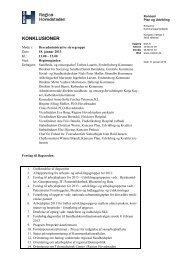Territorial Review Copenhagen - Region Hovedstaden
Territorial Review Copenhagen - Region Hovedstaden
Territorial Review Copenhagen - Region Hovedstaden
You also want an ePaper? Increase the reach of your titles
YUMPU automatically turns print PDFs into web optimized ePapers that Google loves.
219<br />
Box 3.3. Relations between metropolitan areas and central<br />
government: the case of the Randstad<br />
The Randstad is the urbanised western part of the Netherlands, composed of<br />
the four largest cities in the Netherlands (Amsterdam, Rotterdam, The Hague<br />
and Utrecht) and several other smaller cities. This polycentricity requires some<br />
form of co-ordination, especially since the proximity of the different urban poles<br />
results in many spillover effects. Co-ordination could be required in transport<br />
and economic development, and also as regards cluster development, higher<br />
education, housing and office space, all of which involve numerous government<br />
actors. The Randstad falls within four provinces, and 147 municipalities lie<br />
within its unofficial boundaries, creating a challenge not with regards to<br />
horizontal co-ordination but as regards relations with the central government. A<br />
multiplicity of platforms for co-ordination appears in many cases not to have<br />
resulted in the required co-ordination. In response to a perceived lack of coordination,<br />
the mayors of the four largest cities proposed in 2006 to create one<br />
province for the Randstad. This proposal provoked a lively debate, underlining<br />
both the need for better co-ordination and the difficulty in finding politically<br />
feasible reforms.<br />
Following the OECD Metropolitan <strong>Review</strong> of the Randstad, which was<br />
published in 2007, the Netherlands‘ national government decided to produce a<br />
Randstad urgency program, outlining actions to be taken in the short and long<br />
term. Key themes in this agenda were accessibility, economic dynamism, quality<br />
of life and sustainability, stressing joint responsibility for implementation of the<br />
programme. Rather than trying to change government structures, for example by<br />
creating a Randstad province, the objective was to find partnerships that will be<br />
able to achieve results. A new way of creating the requisite political<br />
commitment has been to propose two responsible partners for each project. One<br />
central government minister or state secretary and one regional politician are<br />
made responsible for the progress of the project. Funds were made available for<br />
33 projects. A Minister for the Randstad has been appointed who will hold the<br />
33 sets of partners accountable for progress on their projects.<br />
3.2.3 Representation of interests of <strong>Copenhagen</strong> in Danish<br />
Parliament<br />
Denmark has a proportional parliamentary system with considerable<br />
regional malapportionment. The 179 members of its unicameral parliament,<br />
the Folketing, are elected by a two-tier, six-stage proportional representation<br />
system. A total of 135 seats are filled by multi-member electoral districts<br />
grouped into three electoral regions. The remaining 40 seats are<br />
compensatory seats, to guarantee that the distribution of seats reflects not<br />
only the dominance of parties in the regions, but is also proportional on a

















